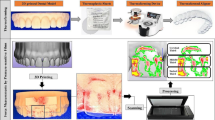Abstract.
Aim:
Registration of the orthodontic forces and moments acting with different types of pendulum appliance for non-compliance upper molar distalization in an in vitro study.
Material and Methods:
The purpose-designed test set-up comprised the following components: artificial maxilla with anchorage unit and two electrothermodynamic (ETD) molars, electronic measuring unit for temperature control and regulation, and a sensor unit with force-moment sensor, analog/digital converter and data readout unit. This set-up permitted virtually authentic simulation of in vivo conditions on the one hand and precise determination of the force systems on the other.
The appliances investigated were the standard pendulum appliance with U-loop activation according to Hilgers and with uprighting activation according to Byloff, the M-pendulum with U-loop activation according to Scuzzo, and the Pendulum K with initial uprighting activation, toe-in bend and incorporated distal screw according to Kinzinger.
Results and Conclusions:
The effects shown by the standard pendulum appliance and the M-pendulum over a 3 mm simulated distalization increment were a marked decrease in the distally directed forces, and an increase in the intrusive and palatally directed forces as well as in the distoinclinatory, mesially inward, and palatally rotating moments.
Activations in the U-loop region of the pendulum springs induced an increase in distally and buccally directed forces and in uprighting and buccally rotating moments as well as a marked rise in extrusive forces. Whereas the activation described by Hilgers led to mesially outward rotating moments, activation according to Scuzzo resulted in a further increase in the mesially inward rotating moments.
In the measured standard pendulum appliances, uprighting activation at the end of the pendulum according to Byloff led to an increase in distally and buccally directed as well as in mildly intrusive forces, and to an increase in uprighting as well as in buccally and mesially outward rotating moments.
With the Pendulum K according to Kinzinger, the initial toe-in bend and uprighting activation in the region of the end of the pendulum spring together with regular adjustment of the incorporated distal screw permitted virtually translatory molar distalization: constantly distalizing forces with slight intrusive, buccally directed, and rotating side effects.
Zusammenfassung.
Ziel:
In einer In-vitro-Studie wurden die orthodontisch wirkenden Kräfte und Momente bei verschiedenen Pendelapparaturtypen zur kooperationsunabhängigen Molarendistalisation im Oberkiefer erfasst.
Material und Methoden:
Die spezielle Versuchsanordnung bestand aus folgenden Komponenten: künstlicher Oberkiefer mit Verankerungseinheit und zwei elektrothermodynamischen (ETD) Molaren, elektronische Messeinheit zur Temperaturkontrolle und -regelung und eine Sensoreinheit mit Kraft-Moment-Sensor, Analog-Digital-Wandler und Datenausleseeinheit. Diese Anordnung ermöglichte einerseits eine weitestgehend authentische Simulation der In-vivo-Verhältnisse, andererseits eine exakte Bestimmung der Kräftesysteme.
Vermessen wurde die Standard-Pendelapparatur mit U-Loop-Aktivierung nach Hilgers und mit der Aufrichteaktivierung nach Byloff, das M-Pendulum mit U-Loop-Aktivierung nach Scuzzo sowie das Pendulum K mit initialer Aufrichteaktivierung, Toe-in-Biegung und inkorporierter Distalschraube nach Kinzinger.
Ergebnisse und Schlussfolgerungen:
Bei der Standard-Pendelapparatur und beim M-Pendulum ergaben sich über eine simulierte Distalisationsstrecke von 3 mm folgende Effekte: deutliche Abnahme der nach distal gerichteten Kräfte, Zunahme der intrudierenden und nach palatinal gerichteten Kräfte sowie der distoinklinatorischen, mesial-einwärts und palatinal rotierenden Momente.
Aktivierungen im U-Loop-Bereich der Pendelfedern bewirkten eine Zunahme der nach distal und vestibulär gerichteten Kräfte sowie aufrichtender und bukkal-rotierender Momente, aber auch einen starken Anstieg der extrudierenden Kräfte. Während die von Hilgers beschriebene Aktivierung zu mesial-auswärts rotierenden Momenten führte, kam es bei einer Aktivierung nach Scuzzo zu einem weiteren Anstieg der mesial-einwärts rotierenden Momente.
Die Aufrichteaktivierung am Pendelendstück nach Byloff führte bei den vermessenen Standard-Pendelapparaturen zu einer Zunahme der nach distal und vestibulär gerichteten sowie leicht extrudierenden Kräfte sowie zu einem Anstieg der aufrichtenden, bukkal und mesial-auswärts rotierenden Momente.
Beim Pendulum K nach Kinzinger ermöglichte die initiale Toe-in-Biegung und Aufrichteaktivierung im Bereich des Endstücks der Pendelfeder sowie das regelmäßige Verstellen der inkorporierten Distalschraube eine nahezu translatorische Molarendistalisation: konstant distalisierende Kräfte mit geringen intrusiven, nach vestibulär gerichteten und rotierenden Neben effekten.
Similar content being viewed by others
Author information
Authors and Affiliations
Corresponding author
Rights and permissions
About this article
Cite this article
Kinzinger, G., Syrée, C., Fritz, U. et al. Molar Distalization with Different Pendulum Appliances: In Vitro Registration of Orthodontic Forces and Moments in the Initial Phase. J Orofac Orthop 65, 389–409 (2004). https://doi.org/10.1007/s00056-004-0406-z
Received:
Accepted:
Issue Date:
DOI: https://doi.org/10.1007/s00056-004-0406-z




